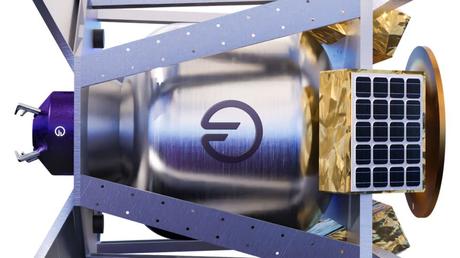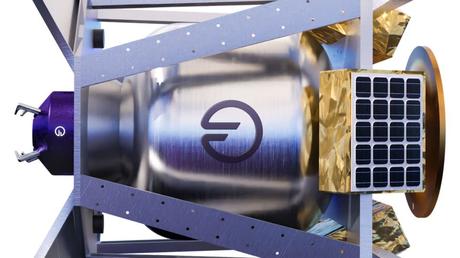Since the beginning of the Space Age - the launch of Sputnik I in 1957 - humans have placed more than 15,000 satellites into orbit. Just over half are still functioning; the rest, after running out of fuel and ending their useful life, have either burned up in the atmosphere or are still orbiting the planet as useless hunks of metal.
As such, they pose a threat to the International Space Station and other satellites, with the European Space Agency estimating that more than 640 "ruptures, explosions, collisions or abnormal events leading to fragmentation" have occurred to date.
That has created an aura of space debris around the planet, consisting of 36,500 objects larger than 10 centimeters (3.94 inches) and as many as 130 million fragments up to 1 centimeter (0.39 inches). Cleaning up this debris is expensive and complicated. There are several plans to do this, but no tangible results have been achieved yet.
One way to tackle the problem would be to stop producing more junk - by refueling satellites rather than dismantling them when they run out of power.
"Right now you can't fuel a satellite in orbit," said Daniel Faber, CEO of Orbit Fab. But his Colorado-based company wants to change that.
"If satellites run out of fuel, you can't keep them in the right place in orbit and they become dangerous debris, floating around at very high speeds and risking collisions," Faber explains. "But the lack of fuel also creates a whole paradigm in which people design their spacecraft missions to move as little as possible.
"That means we can't have tow trucks in orbit to remove any remaining debris. We can't do repairs and maintenance, we can't upgrade anything. If it breaks, we can't inspect anything. There are so many things we can't do and we operate in a very limited way. That is the solution we are trying to provide."
Space surgery
The concept of refueling and servicing satellites in orbit was developed by NASA in 2007, when - in collaboration with DARPA (the research arm of the US Department of Defense) and Boeing - it launched Orbital Express, a mission with two purpose-built satellites that successfully docked and exchanged fuel. Later, NASA worked on the Robotic Refueling Mission (RRM), which further explored the challenges of refueling existing satellites.
The story continues
Now the agency is working on OSAM-1, which is expected to launch in 2026 and will attempt to grab and refuel Landsat-7, an Earth observation satellite that has run out of gas.
"This is a mission to refuel a satellite that was not prepared to be refueled," says Faber. "So they actually have to do an operation on the satellite, where they have to cut into it to access the fuel lines. This creates impressive satellite repair capabilities, but it comes at a price." NASA said OSAM-1 will cost about $2 billion in total.
Orbit Fab has no plans to address its existing fleet of satellites. Instead, it wants to focus on those that have yet to launch, equipping them with a standardized port - called RAFTI, which stands for Rapid Attachable Fluid Transfer Interface - that would dramatically simplify refueling and keep the price tag low.
"What we want to do is create a low-cost architecture," says Faber. "There is not yet a commercially available fuel port for refueling an orbiting satellite. For all the big ambitions we have for a vibrant space economy, we are actually working on the gas cap - we are a gas cap company."


Orbit Fab, which advertises itself with the tagline "gas stations in space," is working on a system that includes the fuel port, shuttle refueling - which would deliver the fuel to a satellite in need - and refueling tankers, or orbital gas stations . from which the shuttles could pick up the fuel. It has advertised a price of $20 million for the delivery into space of hydrazine, the most common satellite propellant.
In 2018, the company launched two test beds to the International Space Station to test the interfaces, pumps and pipes. In 2021, it launched Tanker-001 Tenzing, a fuel depot demonstrator that informed the design of the current hardware.
The next launch is now scheduled for 2024. "We are delivering fuel into geostationary orbit for a mission conducted by the Air Force Research Lab," Faber said. "Right now they're treating it as a demonstration, but it's getting a lot of interest from across the U.S. government, from people who realize the value of refueling."
Orbit Fab's first private customer will be Astroscale, a Japanese satellite services company that developed the first satellite designed for refueling. It's called LEXI, will mount RAFTI ports and is currently scheduled to launch in 2026.
An original approach
According to Simone D'Amico, associate professor of aerospace at Stanford University, who is not affiliated with Orbit Fab, in-space maintenance is one of the keys to ensuring the safe and sustainable development of space. "Can you imagine a ground mobility infrastructure, roads and cities, without gas stations and car repair shops? Can you imagine single-use cars or airplanes?" he asks. "The development of space infrastructure and the proliferation of space assets are reaching a critical volume that is no longer sustainable without a paradigm shift."
D'Amico adds that there are many reasons why this hasn't happened sooner, including, until recently, a lack of perceived need given the limited number of spacecraft, and the fact that space servicing technology has only now become economically viable due to the limited number of spacecraft. to make progress in satellite miniaturization.
He believes Orbit Fab is original, especially from a marketing perspective. "It's probably the only company in the world that has positioned itself to put 'gas stations' in orbit," he says. "I think Orbit Fab's approach is truly visionary and can pay off in the medium to long term. However, in the short term this poses a major risk because satellites must be designed for reusability and refueling."
Initially, Orbit Fab plans to find its market as a supplier of fuel to companies, such as Astroscale, that plan to inspect, repair and upgrade satellites in orbit, or perform debris collection. According to Faber, success in this sector could convince the major telecom companies, which operate a large number of satellites, to shake up their business model and embrace fueling and service.
He adds that once the pattern of sending and delivering fuel into orbit is established, the next step is to start making the fuel there. "In ten to fifteen years we want to build refineries in orbit," he says, "where we process material launched from the ground into a range of chemicals that people want to buy: air and water for commercial space stations, 3D printer raw material minerals to grow plants. We want to be the industrial chemical supplier for the emerging commercial space industry."
For more CNN news and newsletters, create an account at CNN.com
